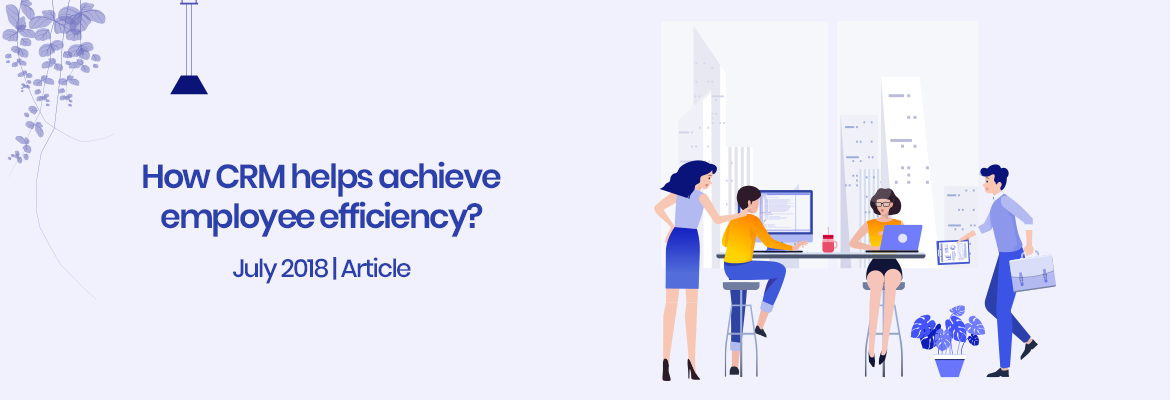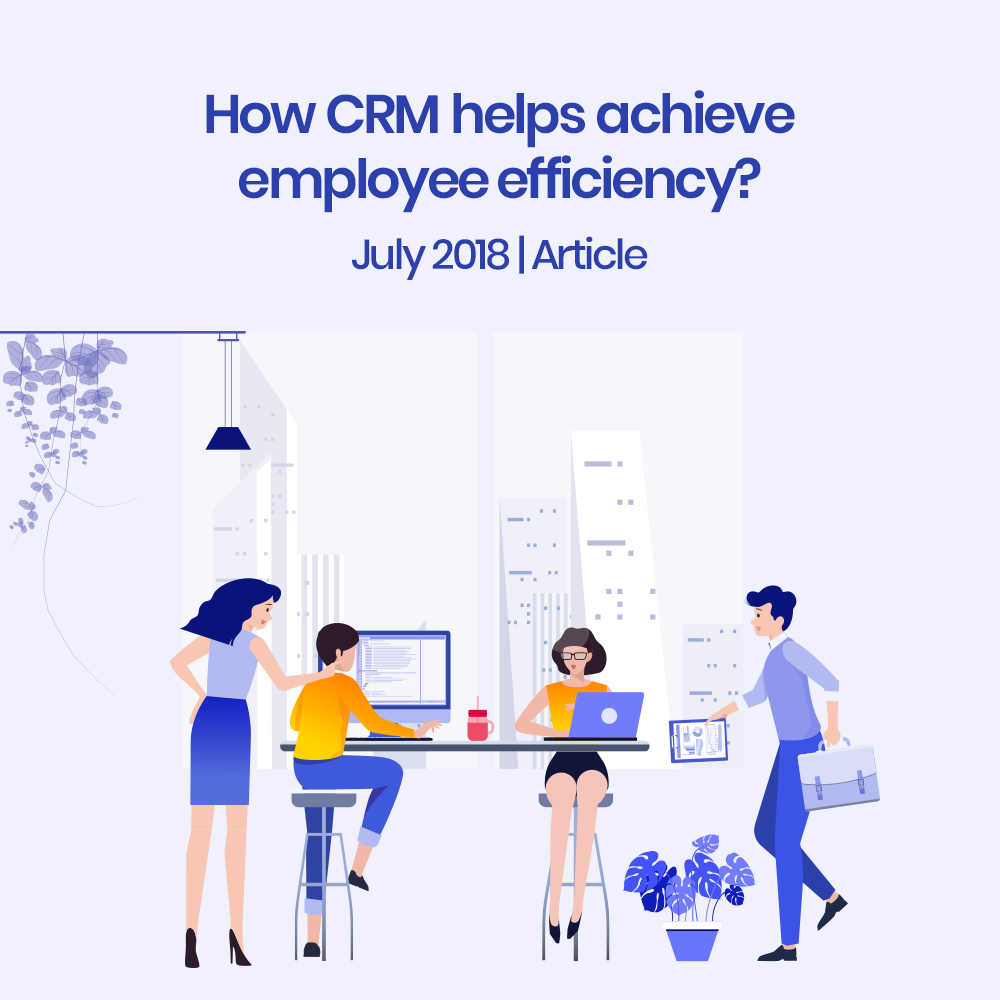

The evolving organizational need to become customer-centric and build company-wide customer-serving strategies has led CRM to become a globally accepted phenomenon across all industries, geographies, and organizational sizes. Nearing $50 billion in market size by 2019, (Gartner), CRM is now the biggest subsegment of the enterprise software market and it does so by enabling sales, service, and marketing streams to achieve a single, 360-degree view of the customers. Hence, it assists with the acquisition of new ones, offering tailored services to retain existing ones, and using the effective cross and upsell techniques to grow their value over time. And while the benefits of how a CRM develops such customer silos usually take the spotlight, not much is said about the operational and employee-centric side of things that it enables and embodies. Let’s explore some of these and realize the impact this lens makes towards the growth and profitability goals of an organization:
Breaks silos and promotes employee collaboration
According to Salesforce research, 86% of employees list a lack of collaboration as a top reason for workplace failures. Imagine having to serve modern-day customers with consistent experiences across all touchpoints without the alignment of the key internal stakeholders. The right CRM becomes a centralized hub and promotes such collaboration through cross-company insights through reports and dashboards for aligned goal sharing and cross-platform performance measurement. These collective organizational objectives set the organization up for longer-term success, avoids hindrances in data and resource sharing, and promotes competition from within to achieve excellence for the larger cause of the organization.
Identifies and measures relevant performance metrics
 The golden era of Relationship Marketing of the 90’s changed the way organizations define and measure success. With a focus on building long-term customer relationships and gaining efficiencies in metrics that measure its value (customer lifetime value, cost of customer acquisition, customer equity, etc.), businesses have doubled down again and again on this and the importance of this measure has increased multiple folds over time. Rightfully so as it is even more essential for employees to comprehend these moving goalposts of success and identify, measure, and evolve metrics that continue to move the growth and profitability needle for the business. A CRM, through its in-built reporting and analytics and journey building capabilities, enables a direct link towards the goals of customer retention and loyalty and improves employee access to customer data (which 74% of CRM users claim the system helps achieve) that allows them to focus on improving the customer experience rather than scrambling for the right data or wondering about hitting the right metric of success.
The golden era of Relationship Marketing of the 90’s changed the way organizations define and measure success. With a focus on building long-term customer relationships and gaining efficiencies in metrics that measure its value (customer lifetime value, cost of customer acquisition, customer equity, etc.), businesses have doubled down again and again on this and the importance of this measure has increased multiple folds over time. Rightfully so as it is even more essential for employees to comprehend these moving goalposts of success and identify, measure, and evolve metrics that continue to move the growth and profitability needle for the business. A CRM, through its in-built reporting and analytics and journey building capabilities, enables a direct link towards the goals of customer retention and loyalty and improves employee access to customer data (which 74% of CRM users claim the system helps achieve) that allows them to focus on improving the customer experience rather than scrambling for the right data or wondering about hitting the right metric of success.
Reduces mundane tasks to increase productivity
An average salesperson spends only 39% of their time selling (Cirrus Insight) and the remainder is consumed in administrative tasks that can be extremely counterproductive and ideally, should be automated. The right CRM alleviates this and arms them with the right data (in the right way) to focus on building relationships and spending time with potentials and clients. Manual, repeated data entries, using private machines/phones to store and share important information can take away the collectiveness of a unified system that makes it easy to collaborate and interact with. Also, the automatic alerts about their prospects’ progress along their journey and automatic collection of lead information during calls are further productivity enhancers. Similarly, for customer support, CRM houses a pre-built repository of knowledge base articles that aid in solving complex customer queries. For marketers, pre-built email and social media templates mean to spend less time on crafting content, and more on optimizing its delivery and personalization per individual customer. If implemented right, CRM users can have a 41% boost in productivity over non-users (Company Hub). It seems like a reason enough to look at one.
Converts old processes into targeted journeys
As product-centric organizations transition to customer-centricity (or look to it), most of their existing business processes will warrant another look as they were originally designed with the product in mind. This conversion of processes into success journeys requires a concerted re-imagining and re-engineering effort as the core tenets of both strategies differ from each other. The right CRM system can play a pivotal role in such a transition as it can methodically analyze journeys and identify and eliminate redundancies in sales, service, and marketing areas especially with Omni-channels, complex hierarchies, and the countless ways customers wish to engage with a brand. This productive journey binge can be directly equated to an increase in revenue as sales alone sees an average of a 42% surge per salesperson (TrackVia). Similarly, as traditional mass marketing channels (television, radio, etc.) fizzle out and the new ones take over, it can help marketers identify a better mix of mediums from which to broadcast their message and tie in the impact on profitability. It can also identify and augment processes that enable workers to produce more value while eliminating those that don’t. A success formula all around.
Provides contextual insights via reporting tools
The increased power of built-in and on-demand reporting tools in CRM solutions are a major reason for their success. As customer relationships become increasingly complex (due to the number of channels, new digital mediums, elongated journeys, etc.), analyzing them and finding what works grows in importance every day. Without the use of these advanced features, efficiencies cannot be gained around decreasing sales cycles and identifying potential opportunities, hurdles, and threats to customer relationships to help stay ahead of changing behavioral patterns and market trend analyses around products and services that do better than others.
Adds insightful firepower
Artificial intelligence, with its power to simplify decision-making and business processes, is regularly touted as CRM’s next major frontier. Features like sentiment analysis and behavioral intent (which have become increasingly powerful because of natural language processing) enable platforms like Salesforce Einstein to score customer satisfaction and forecast profitability more reliably and the rise of AI-powered chat and voice bots and its increased application in CRM reduces the reliance on call centers and human workers as well. On the sales side, automatic transcribing of sales calls (and running analyses on them) and predictive lead scoring (based on publicly available data) reduce the amount of time employees spend manually and make them more efficient. For marketers, Adobe suggests a sharp incline in productivity if AI is mixed in especially if it integrates with the creation and distribution of intelligent content (Wordsmith and others) and intelligent account-based marketing (that adds resources based on the worth of the relationships).
Achieve CRM success; the TransformX way
By directly augmenting organizational relationships with their most important stakeholders in the modern day, the customer, a CRM fast tracks the way in which organizational value is created. The TransformX Customer Success Model assists clients in achieving this by assessing their readiness to take on a CRM implementation and leveraging a methodical, proprietary and industry-leading approach to help select the best fit solution that will add comprehensive value for their customer-related goals. The processes include sessions and interviews with key organizational stakeholders to comprehend the real needs and showcase short and long-term roadmaps for achieving customer success across the board. A bespoke CRM RFP effort is also conducted to compare the solutions against 15 dimensions of success from the model. In cases where a CRM is already in use, a comprehensive value and impact review is performed to underpin any potential failings in the current solution and similar tacts are leveraged to recommend one that fits the need better. TransformX clients have leveraged this model over the years to add value to their customer relationships, reduced costs of acquisition, increased customer satisfaction scores (CSAT, NPS, etc.) increased customer retention, grown customer lifetime value, and achieved further benefits and growth in this realm. We welcome you to review the Success Page on our website to gain more insight into the success stories of our clients and we look forward to engaging with you and your teams to assist in the success of your next CRM or customer-related effort.
The evolving organizational need to become customer-centric and build company-wide customer-serving strategies has led CRM to become a globally accepted phenomenon across all industries, geographies, and organizational sizes. Nearing $50 billion in market size by 2019, (Gartner), CRM is now the biggest subsegment of the enterprise software market and it does so by enabling sales, service, and marketing streams to achieve a single, 360-degree view of the customers. Hence, it assists with the acquisition of new ones, offering tailored services to retain existing ones, and using the effective cross and upsell techniques to grow their value over time. And while the benefits of how a CRM develops such customer silos usually take the spotlight, not much is said about the operational and employee-centric side of things that it enables and embodies. Let’s explore some of these and realize the impact this lens makes towards the growth and profitability goals of an organization:
Breaks silos and promotes employee collaboration
According to Salesforce research, 86% of employees list a lack of collaboration as a top reason for workplace failures. Imagine having to serve modern-day customers with consistent experiences across all touchpoints without the alignment of the key internal stakeholders. The right CRM becomes a centralized hub and promotes such collaboration through cross-company insights through reports and dashboards for aligned goal sharing and cross-platform performance measurement. These collective organizational objectives set the organization up for longer-term success, avoids hindrances in data and resource sharing, and promotes competition from within to achieve excellence for the larger cause of the organization.
Identifies and measures relevant performance metrics
The golden era of Relationship Marketing of the 90’s changed the way organizations define and measure success. With a focus on building long-term customer relationships and gaining efficiencies in metrics that measure its value (customer lifetime value, cost of customer acquisition, customer equity, etc.), businesses have doubled down again and again on this and the importance of this measure has increased multiple folds over time. Rightfully so as it is even more essential for employees to comprehend these moving goalposts of success and identify, measure, and evolve metrics that continue to move the growth and profitability needle for the business. A CRM, through its in-built reporting and analytics and journey building capabilities, enables a direct link towards the goals of customer retention and loyalty and improves employee access to customer data (which 74% of CRM users claim the system helps achieve) that allows them to focus on improving the customer experience rather than scrambling for the right data or wondering about hitting the right metric of success.
Reduces mundane tasks to increase productivity
An average salesperson spends only 39% of their time selling (Cirrus Insight) and the remainder is consumed in administrative tasks that can be extremely counterproductive and ideally, should be automated. The right CRM alleviates this and arms them with the right data (in the right way) to focus on building relationships and spending time with potentials and clients. Manual, repeated data entries, using private machines/phones to store and share important information can take away the collectiveness of a unified system that makes it easy to collaborate and interact with. Also, the automatic alerts about their prospects’ progress along their journey and automatic collection of lead information during calls are further productivity enhancers. Similarly, for customer support, CRM houses a pre-built repository of knowledge base articles that aid in solving complex customer queries. For marketers, pre-built email and social media templates mean to spend less time on crafting content, and more on optimizing its delivery and personalization per individual customer. If implemented right, CRM users can have a 41% boost in productivity over non-users (Company Hub). It seems like a reason enough to look at one.
Converts old processes into targeted journeys
As product-centric organizations transition to customer-centricity (or look to it), most of their existing business processes will warrant another look as they were originally designed with the product in mind. This conversion of processes into success journeys requires a concerted re-imagining and re-engineering effort as the core tenets of both strategies differ from each other. The right CRM system can play a pivotal role in such a transition as it can methodically analyze journeys and identify and eliminate redundancies in sales, service, and marketing areas especially with Omni-channels, complex hierarchies, and the countless ways customers wish to engage with a brand. This productive journey binge can be directly equated to an increase in revenue as sales alone sees an average of a 42% surge per salesperson (TrackVia). Similarly, as traditional mass marketing channels (television, radio, etc.) fizzle out and the new ones take over, it can help marketers identify a better mix of mediums from which to broadcast their message and tie in the impact on profitability. It can also identify and augment processes that enable workers to produce more value while eliminating those that don’t. A success formula all around.
Provides contextual insights via reporting tools
The increased power of built-in and on-demand reporting tools in CRM solutions are a major reason for their success. As customer relationships become increasingly complex (due to the number of channels, new digital mediums, elongated journeys, etc.), analyzing them and finding what works grows in importance every day. Without the use of these advanced features, efficiencies cannot be gained around decreasing sales cycles and identifying potential opportunities, hurdles, and threats to customer relationships to help stay ahead of changing behavioral patterns and market trend analyses around products and services that do better than others.
Adds insightful firepower
Artificial intelligence, with its power to simplify decision-making and business processes, is regularly touted as CRM’s next major frontier. Features like sentiment analysis and behavioral intent (which have become increasingly powerful because of natural language processing) enable platforms like Salesforce Einstein to score customer satisfaction and forecast profitability more reliably and the rise of AI-powered chat and voice bots and its increased application in CRM reduces the reliance on call centers and human workers as well. On the sales side, automatic transcribing of sales calls (and running analyses on them) and predictive lead scoring (based on publicly available data) reduce the amount of time employees spend manually and make them more efficient. For marketers, Adobe suggests a sharp incline in productivity if AI is mixed in especially if it integrates with the creation and distribution of intelligent content (Wordsmith and others) and intelligent account-based marketing (that adds resources based on the worth of the relationships).
Achieve CRM success; the TransformX way
By directly augmenting organizational relationships with their most important stakeholders in the modern day, the customer, a CRM fast tracks the way in which organizational value is created. The TransformX Customer Success Model assists clients in achieving this by assessing their readiness to take on a CRM implementation and leveraging a methodical, proprietary and industry-leading approach to help select the best fit solution that will add comprehensive value for their customer-related goals. The processes include sessions and interviews with key organizational stakeholders to comprehend the real needs and showcase short and long-term roadmaps for achieving customer success across the board. A bespoke CRM RFP effort is also conducted to compare the solutions against 15 dimensions of success from the model. In cases where a CRM is already in use, a comprehensive value and impact review is performed to underpin any potential failings in the current solution and similar tacts are leveraged to recommend one that fits the need better. TransformX clients have leveraged this model over the years to add value to their customer relationships, reduced costs of acquisition, increased customer satisfaction scores (CSAT, NPS, etc.) increased customer retention, grown customer lifetime value, and achieved further benefits and growth in this realm. We welcome you to review the Success Page on our website to gain more insight into the success stories of our clients and we look forward to engaging with you and your teams to assist in the success of your next CRM or customer-related effort.




